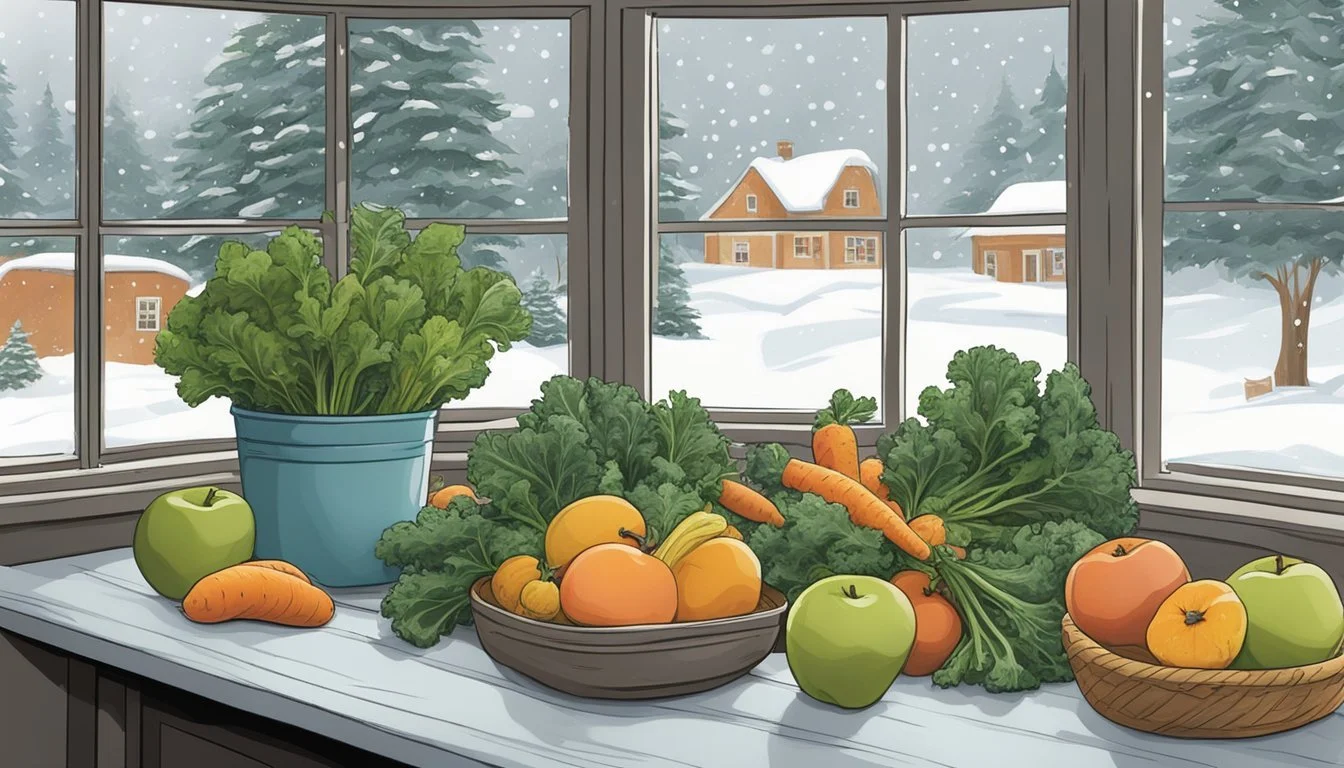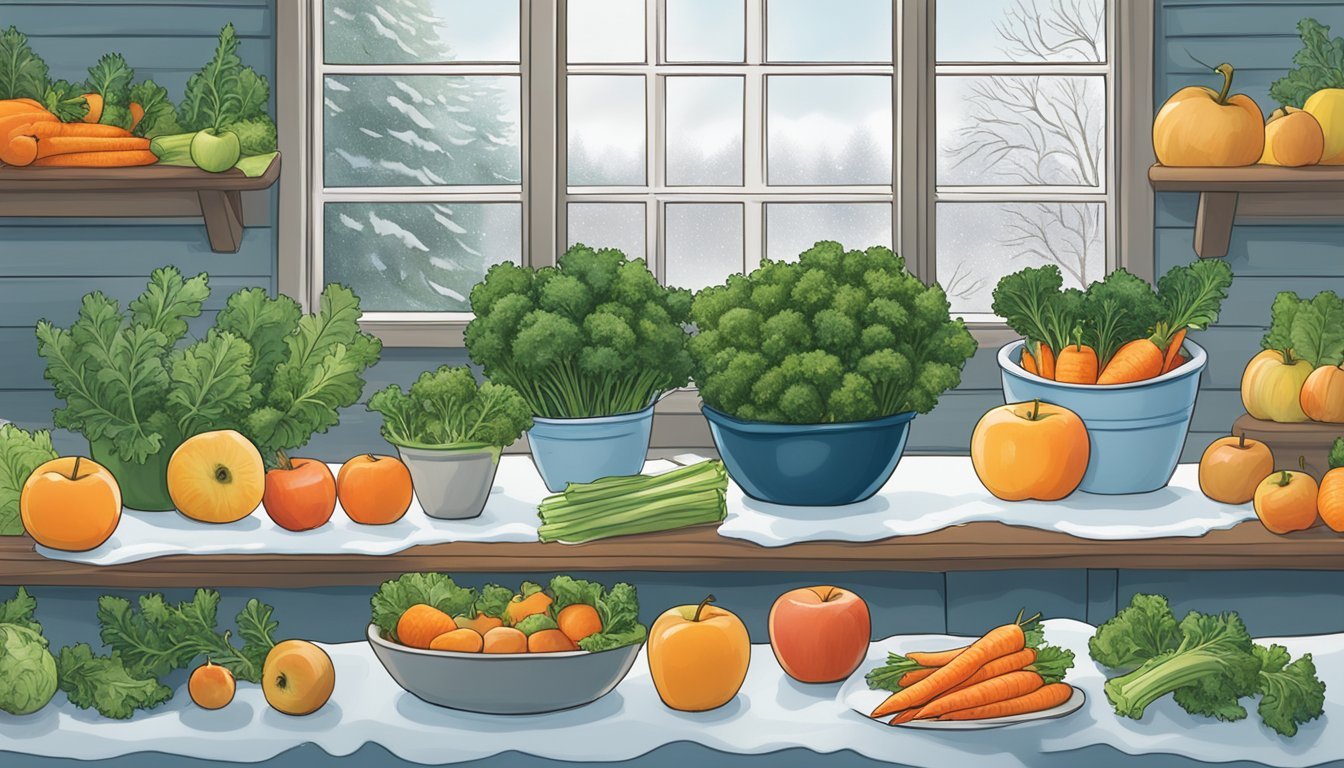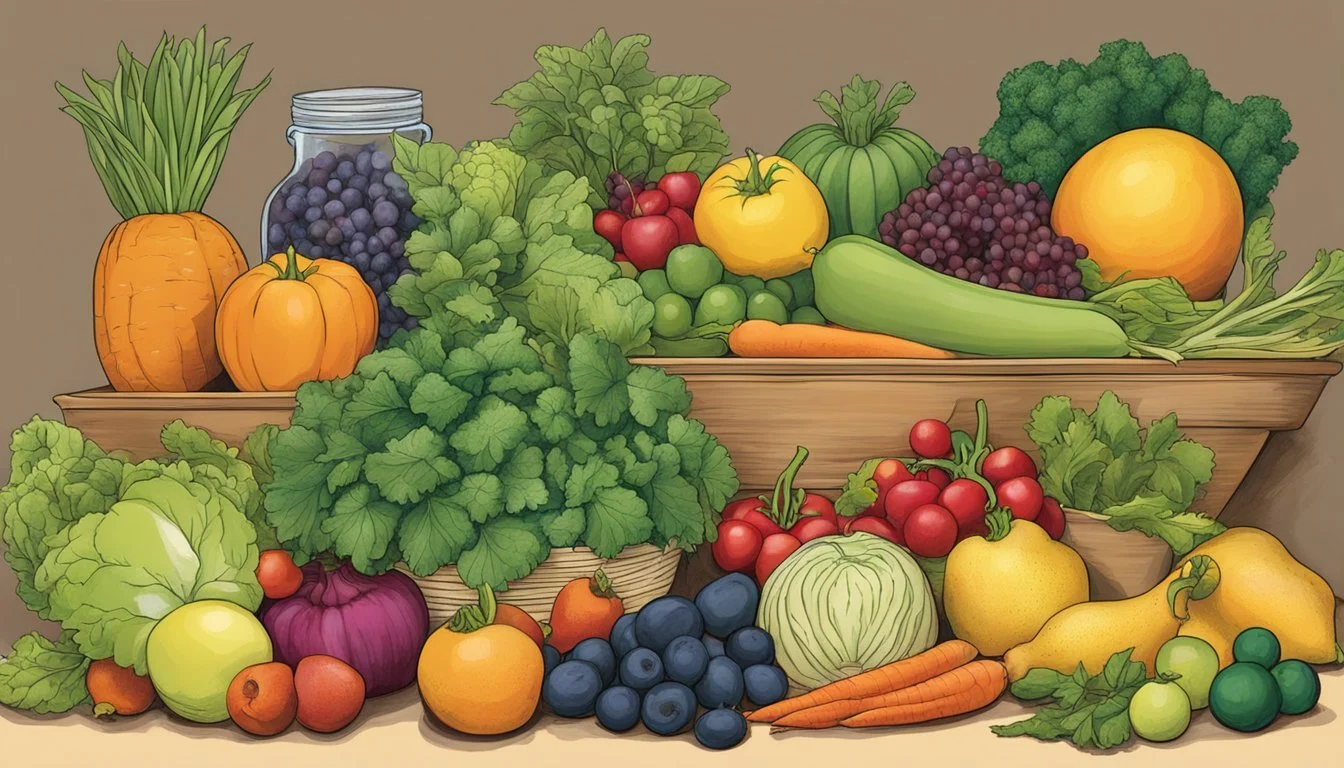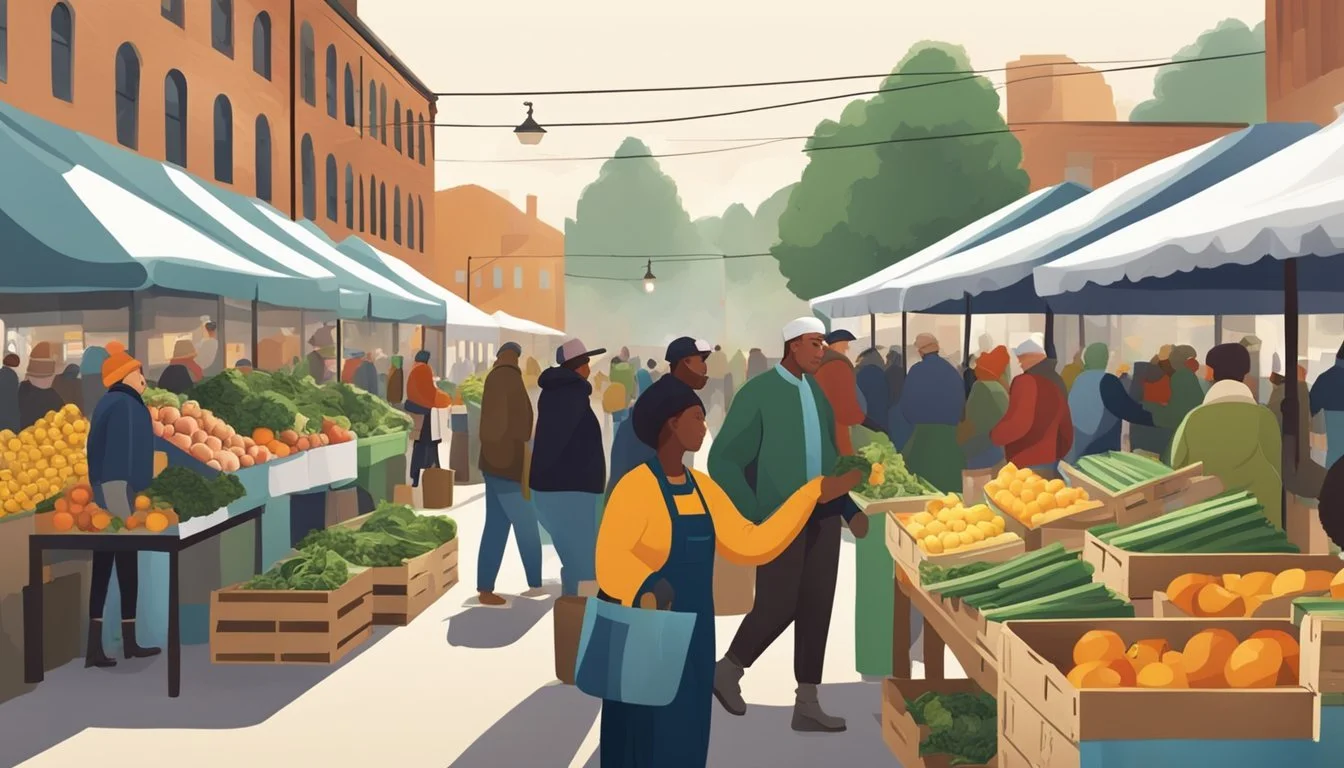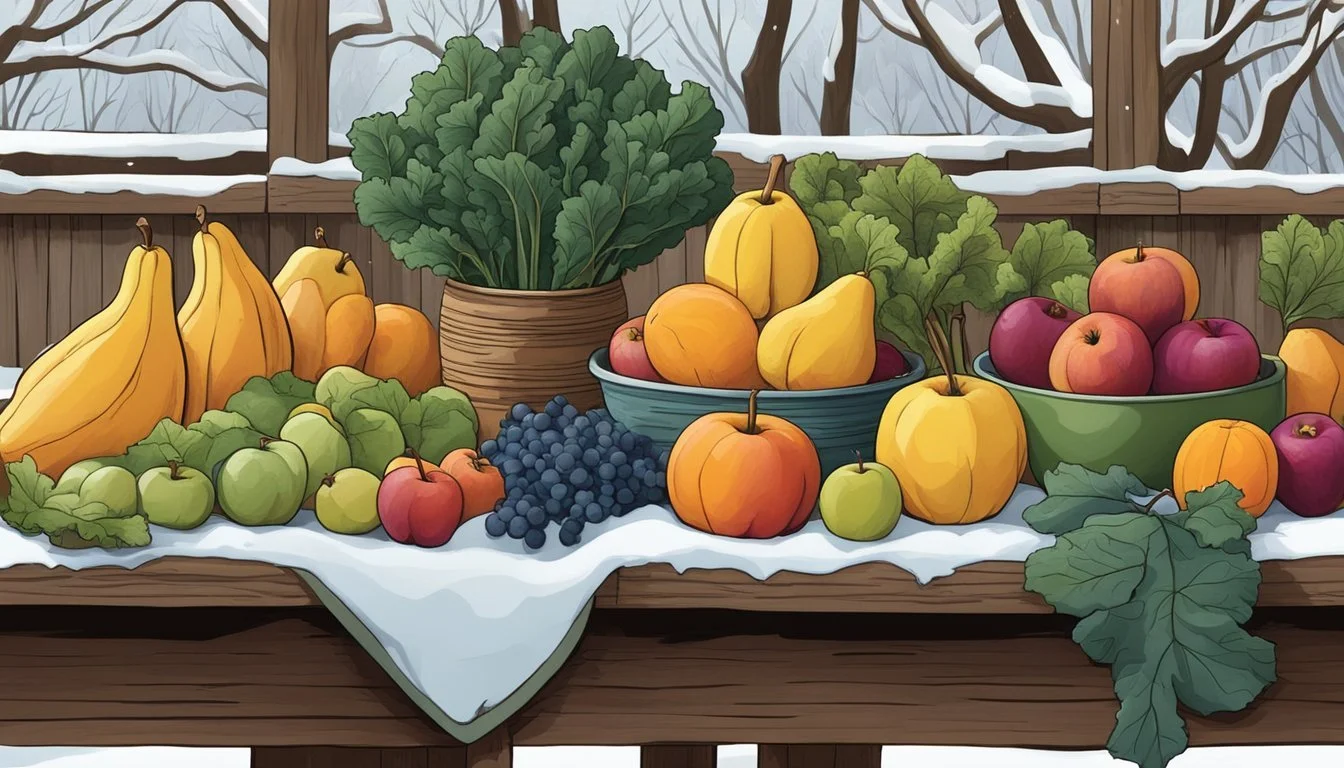Delaware Seasonal Fruit & Vegetables in January
A Guide to Local Produce
This Article is Part of our Delaware Seasonal Fruit & Veg Calendar
In the heart of winter, Delaware's fields and orchards are largely at rest, yet a range of hearty produce still thrives. Despite January's chill, the state's seasonal offerings are robust with a selection of fruits and vegetables that are not only fresh but also packed with nutrients. The seasonal produce available provides a blend of flavors and health benefits suitable for a variety of dishes.
In the first month of the year, Delawareans can savor the bold flavors of citrus, brightening the coldest days with a burst of zest. Root vegetables such as carrots (how long do carrots last?) and turnips, staples of winter cooking, are also abundant. They can be roasted, mashed, or stewed to add depth and warmth to meals. Additionally, the greens fields are not bare; kale and collard greens (how long do collard greens last?) remain in season, offering versatility and a wealth of vitamins to winter diets.
Furthermore, while many associate lush berries and crisp apples (how long do apples last?) with summer and fall, storage technologies and controlled atmosphere facilities extend the availability of apples into the winter months, ensuring that even in January, a crisp bite of an apple can be enjoyed. Celery and leeks also join the roster of January produce, demonstrating that even in the quieter months of the year, Delaware's harvest yields a satisfying range of options for consumers seeking fresh, local, and seasonal fare.
Understanding Seasonality
The concept of seasonality in agriculture is critical, especially when discussing the availability of fresh produce in Delaware during winter months. It dictates not only what is in season but also the quality and abundance of the produce available.
Seasonal Patterns
In Delaware, seasonal patterns are marked by the fluctuations in temperature and daylight hours, which influence the growth cycles of fruits and vegetables. Winter typically sees a reduced variety of fresh local produce; however, some hearty crops can withstand the cold.
Typical winter produce includes:
Root vegetables (e.g., carrots, turnips)
Hardy greens (e.g., kale, collards)
Stored apples from late autumn harvests
Weather Influence on Crops
The weather in Delaware, with its cold winters, plays a significant role in determining crop viability. Frost and snow can halt growth or even kill sensitive plants. Growers often use greenhouses or other methods to protect certain crops, enabling them to provide in-season produce out of their usual outdoor growing timetable.
Use of hoop houses
Cold storage techniques
Benefits of Seasonal Eating
Consuming produce that is in season offers numerous benefits. These items are often fresher, providing better flavor and nutritional value than off-season imports. Furthermore, seasonal eating supports the local Delaware economy and is generally more environmentally friendly due to reduced transportation requirements.
Advantages of seasonal eating:
Fresher, more flavorful food
Lower environmental impact
January's Harvest in Delaware
Despite the cold weather, January in Delaware remains a surprisingly resourceful month for those seeking fresh, local produce. The harvest calendar showcases a variety of hearty vegetables and the tail end of the citrus season fruits available in this month.
Vegetables in Season
Root Vegetables: The chilly January soil of Delaware is home to a selection of robust root vegetables. Notable harvests include:
Carrots: Sweet and crisp, ideal for a variety of dishes.
Sweet Potatoes: Rich in flavor and nutrients, versatile in cooking.
Turnips: Earthy and nutritious, a staple in winter recipes.
Potatoes: A hearty staple that stores well during cold months.
Additionally, some leafy greens remain hardy throughout the winter:
Kale: This nutrient-dense green thrives, offering a fresh taste and versatility in winter meals.
Fruits in Season
Citrus: As January marks the tail end of the citrus season in Delaware, it's the last call for:
Lemons: Bright and tangy, perfect for adding freshness to dishes.
While not as abundant as other months, local farm markets may still offer:
Apples: A few hardy varieties remain crisp and delicious, stored from the fall harvest.
Winter Squash: Although not technically a fruit, winter squash like butternut can still be found, rounding out the January selection with its sweet, nutty flavor.
Delaware's harvest in January may not be as extensive as the summer or fall months, but residents can still find a variety of fruits and vegetables to enjoy.
Nutritional and Culinary Guide
This section dives into the health benefits of Delaware’s seasonal produce and offers practical cooking and preparation tips to help you make the most of January’s bounty.
Health Benefits
Delaware's January harvest offers a variety of fruits and vegetables rich in nutrients. Kale and other greens like broccoli and cauliflower are loaded with vitamins and minerals; they have high levels of Vitamin C and are packed with fiber. Carrots, often harvested in winter, provide beta-carotene, which the body converts to vitamin A—a key nutrient for eye health. Including a range of seasonal produce in soups, stews, and salads not only enhances flavor but also provides a boost to the immune system during the colder months.
Cooking and Preparation Tips
Vegetables harvested during this time, such as kale and carrots, are incredibly versatile. They can be incorporated into a variety of recipes:
Kale can either be massaged with a bit of olive oil for a tender salad or sautéed to create a nutrient-rich side dish.
Carrots can be roasted to bring out their natural sweetness or sliced to add crunch to a salad. They also blend well into savory dishes and can be used in baking for a nutritious spin on sweets.
When making soups and stews, one can add these vegetables early in the brewing process to allow their flavors to meld with the base of the dish.
For fruits available during January in Delaware, such as various citrus, they are excellent sources of Vitamin C and can brighten up any dish with their acidity and sweetness. They're perfect for zesting or can be segmented to add a juicy burst to salad or dessert recipes.
By incorporating these seasonal items into your diet, you take advantage of the peak nutritional values and flavors they provide.
Gardening and Agricultural Insights
In Delaware, January stands as the ideal time for gardeners to focus their efforts on growing cool-season crops, while the agricultural landscape remains active with the harvesting and storage of root vegetables and winter greens.
Growing Your Own Produce
Delaware gardeners are often successful with root vegetables and leafy greens such as turnips, carrots, and kale during winter months. These crops are resilient and can often withstand the cold, while their growth may be slow. It's vital to have well-draining soil as these plants are susceptible to root rot. Here's a list of what you can plant in January:
Turnips: Require loosened soil up to 12 to 15 inches to accommodate growth.
Carrots: Prefer sandy or loamy soil that allows for deep root development.
Kale: Grows best in well-fertilized soil with good moisture content.
For these vegetables, gardeners should:
Prepare beds by adding compost to enrich soil.
Sow seeds directly, considering appropriate spacing for root expansion.
Mulch to maintain consistent soil temperature and moisture.
Delaware's Agricultural Landscape
Delaware's agricultural landscape in January focuses on managing stored seasonal produce like sweet potatoes, which require careful temperature-controlled conditions to avoid spoilage. Here are the key elements:
Storage: Utilizing methods such as clamping or root cellars to keep produce like sweet potatoes viable through the winter.
Soil care: State advisories often recommend soil testing and preparation during this downtime to ensure optimal conditions for the planting season ahead.
In summary, gardeners and farmers alike continue to optimize the growth and storage of seasonal produce to avoid the pitfalls of winter, ensuring a bountiful harvest in Delaware's rich agricultural tapestry.
Seasonal Recipes and Preservation Methods
January in Delaware is a month where root vegetables and citrus fruits are at their peak. Home cooks can take advantage of this seasonality to create dishes that are both flavorful and nourishing.
Recipes:
Soups: A warm, hearty soup can be prepared using kale, a January vegetable high in nutrients. Adding roasted beets can impart a rich, earthy flavor and vibrant color.
Stews: These thick, comforting dishes can leverage the robust flavors of root vegetables like parsnips and carrots.
Salads: Fresh salads utilize crisp greens and are brightened with citrus segments from lemons or oranges.
Salsa: Citrus salsa, mingled with cilantro and onion, can accompany seafood or be a vibrant condiment for grains.
Desserts: Desserts such as a citrus pound cake or a tangy lemon tart are excellent ways to use January’s lemons and incorporate zest for a fresh burst of flavor.
Preservation Methods:
Freezing: Many vegetables can be blanched and frozen, which preserves most of their flavor and nutritional value. Berries, when in season, can be simply washed, dried, and frozen on a tray before transferring to airtight containers.
Canning: Vegetables and fruits can be turned into jams, jellies, or canned whole in a brine. For example, pickled beets are a way to enjoy the earthy flavors (What wine goes well with earthy flavors?) throughout the year.
Fermenting: Fermenting foods like cabbage to make sauerkraut (how long does sauerkraut last?) or kimchi (how long does kimchi last?) incorporates January produce into food preservation, enhancing the food with probiotics.
Using these methods, one can preserve the taste of the season and potentially reduce food waste, while experimenting with various dishes that feature January's seasonal bounty.
Local Food Systems and Economics
Delaware's local food systems play a pivotal role in supporting the state's economy during the month of January. Despite the cold climate, the distribution of seasonal produce, including root vegetables, remains integral to local and community-based economies.
Farmers' Markets and CSAs
Farmers' markets in Delaware continue to operate in January, albeit with a reduced number of vendors and available produce compared to peak seasons. These markets facilitate direct sales of seasonal produce such as cold-storage apples and the last of the root vegetables. Community Supported Agriculture (CSA) programs also contribute by providing residents with fresh, locally-grown fruits and vegetables. CSA members typically receive a share of the harvest, which often includes winter produce available in January.
Economic Impact of Seasonal Produce
The economic impact of seasonal produce in Delaware is significant. By purchasing locally-grown fruits and vegetables, consumers invest directly in their community, enabling farmers to sustain their operations year-round. The sale of seasonal items not only supports the agricultural sector but also stimulates local economies through related businesses such as food processing, retail consumption, and waste management. The circulation of money within the state bolsters economic resilience, aligning with sustainable practices and endorsing the vitality of Delaware's diverse communities.
Seasonal Events and Activities
In January, Delaware's seasonal calendar transitions from the festive hustle of the holidays to a quieter time of winter activities. Despite the chilly temperatures, there are still a variety of events and activities that cater to the interests of residents and visitors alike.
Christmas Tree Farms: While traditional Christmas tree purchasing is largely complete, some farms offer winter-related activities. Individuals can visit these farms to learn about the cycle of tree farming or participate in end-of-season events.
Winter Harvest: January is not peak time for fruit and vegetable harvests, however, persistent farms offer winter produce like the last of cold-storage apples. Visitors may still have the opportunity to enjoy these remnants of previous seasons' harvests.
Corn Mazes: These are typically closed due to the season, yet plans for the upcoming autumn's designs often begin now.
Seasonal Markets: Farmers' markets adjust to the winter season by offering produce that can be grown in cold weather or stored, such as root vegetables.
Community Events: Post-holiday events may include winter-themed local festivals, indoor craft and gift fairs, or workshops focused on preparation for the spring planting season.
January Activities in Delaware:
Event Type Activity Options Educational Tree farming cycle tours Harvest Activities Visiting winter markets, enjoying cold-storage fruits Crafts & Fairs Attending local indoor craft fairs Planning Preparing for spring planting
Residents take this time to enjoy the slower pace before spring, and those with an interest in agricultural cycles or local produce can find comfort in the subtle continuance of these seasonal offerings.
Environmental Considerations
When considering the environmental impact of seasonal produce in Delaware, one can note several benefits. Seasonal produce, by its nature, generally requires less transportation and thus accrues fewer food miles. For example, selecting local green beans and peas in January can contribute to a reduction in greenhouse gas emissions due to decreased transport distances.
In terms of sustainable agricultural practices, Delaware farmers often employ organic farming methods. These practices eschew synthetic pesticides and fertilizers, thereby fostering soil health and reducing chemical runoff into local waterways. This consideration is paramount, as it supports long-term environmental stewardship.
Eating seasonally also means aligning with the natural production cycles. For crops that are not in season, such as green beans and peas which are typically spring to early summer crops, one might look for varieties that are stored effectively or grown in controlled, more sustainable environments like greenhouses.
Furthermore, consuming local and seasonal produce supports the Delaware economy and ensures the vegetables are at their peak for flavor and nutrition. Here's a brief overview of seasonal produce considerations:
Organic Farming: Enhances soil conservation and water quality.
Local Sourcing: Supports Delaware's farmers, reducing food miles.
Sustainability: Seasonal eating aligns with natural growth cycles, promoting ecological balance.
Ultimately, choosing seasonal and local produce in Delaware can be a more environmentally friendly option, leading to a thriving local ecosystem and community.
Conclusion
In Delaware, January's cold weather leads to a quieter time for farms, yet there remains a selection of produce to be enjoyed. Notably, cold-storage apples persist as a fresh option, offering versatility in both sweet and savory culinary applications, with notable nutritional value due to their fiber and vitamin content.
The local community benefits from the consumption of available seasonal vegetables as well. They can indulge in the comfort of winter dishes featuring root vegetables and leafy greens that are typically harvested during this period. Incorporating such produce into meals supports not only personal health due to their nutrients but also the sustainability of local farming.
To navigate January's offerings, individuals in Delaware can refer to seasonal produce guides. These resources provide insightful information regarding current crops that are typically ready for harvest during the winter month. Residents are encouraged to engage with local farmers and markets to discover and utilize what is in season.
By doing so, they are participating in a cycle that values the locality, seasonality, and the collective health of their community. Supporting local agriculture in January, and throughout the year, helps to ensure that Delaware's agricultural sector remains robust and capable of providing fresh, wholesome food to its inhabitants.

